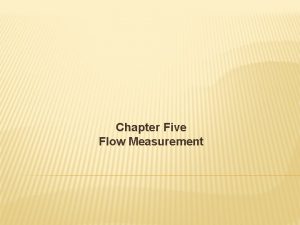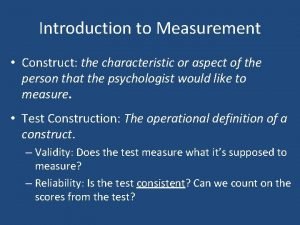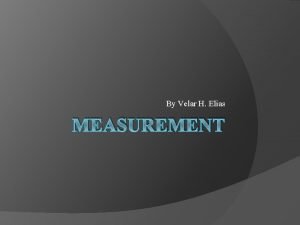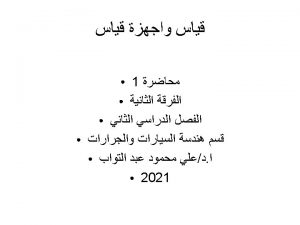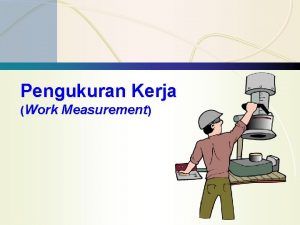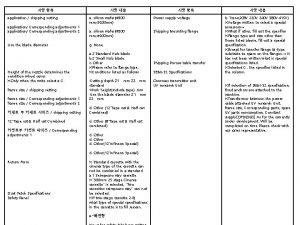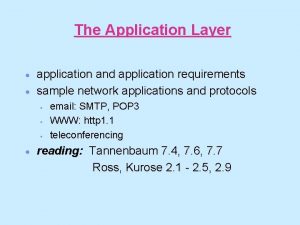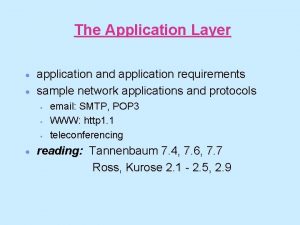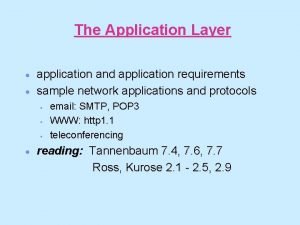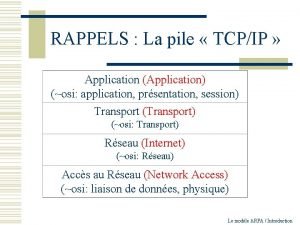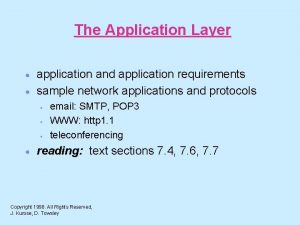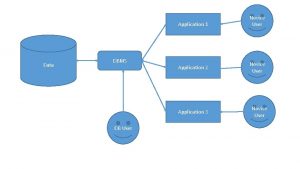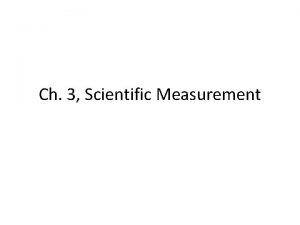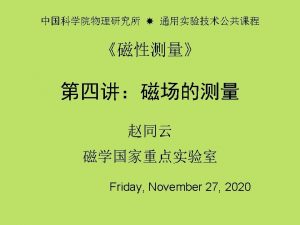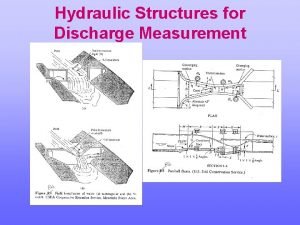Work Measurement Introduction Work measurement is the application











































- Slides: 43

Work Measurement

Introduction • Work measurement is the application of techniques designed to establish the time for a qualified worker to carry out specified jobs at a defined level of performance. • The total time to manufacture a product may be increased by: üadding undesirable features to product, übad operation of the processes, and üineffective time added because of worker and management. • All this leads to decreased productivity. 2

• Work measurement (WM) is concerned with investigating, reducing and eliminating ineffective time, whatever may be the cause. • It is the means of measuring the time taken in the performance of an operation or series of operations in such a way that the ineffective time is shown up and can be separated out. • In practice, proving existence of the ineffective time it is the most difficult task. • After existence is proved, nature and extent is easy to see! 3

• WM is also used to set standard times to carry out the work, so that any ineffective time is not included later. • Any addition to the standard time would show up as excess time and thus can be brought to attention. • Since, standard times are set for all the activities through WM. • Major reason for that it has been the initial focus of the WM methods, which essentially targeted only the worker controllable ineffective times. • Management controllable ineffective times were ignored traditionally. 4

Purpose • To reveal the nature and extent of ineffective time, from whatever cause. • So that action can be taken to eliminate it; and then, • To set standards of performance that are attainable only if all avoidable ineffective time is eliminated and work is performed by the best method available. 5

Uses of WM • To compare the efficiency of alternative methods. Other conditions being equal, the method which takes the least time will be the best method. • To balance the work of members of teams, in association with the multiple activity charts, so that, as far as possible, each member has tasks taking an equal time. • To determine, in association with man and machine multiple activity charts, the number of machines an worker can run. 6

Uses of time standards • To provide information on which the planning and scheduling of production can be based, including the plant and labor requirements for carrying out the program of work and utilization of resources. • To provide information on which estimates for tenders, selling prices and delivery promises can be based. . • To provide information for labor-cost control and to enable standard costs to be fixed and maintained. 7

Techniques for WM • Time study • Activity sampling; and rated activity sampling • Synthesis from standard data or pre-determined motion time system 8

Time study A WM technique for: 1. Recording the times and rates of working for the elements of a specified job carried out under specified conditions, 2. Analyzing the data so as to obtain the time necessary for carrying out the job at a defined level of performance. 9

Selecting a job for time study • A change in material or method of working has been made and a new time standard is required. • A complaint has been received about the time standard for an operation. • A particular operation appears to be “bottleneck” holding up the subsequent operations and possibly previous operations. • Standard times are required prior to the introduction of an incentive scheme. 10

Selecting a job for time study • To investigate the utilization of a piece of plant, the output of which is low, or which appears to be idle for an excessive time. • As a preliminary to making a method study, or to compare the efficiency of two proposed methods. • When the costs of a particular job appears to be excessive. 11

Steps in making a time study • Obtaining and recording all the information about the job, the operator and the surrounding conditions, which is likely to affect the carrying out of the work. • Recording a complete description of the method, breaking down the operation into “elements. ” • Examining the detailed breakdown to ensure that the most effective method and motions are being used. • Measuring and recording the time taken by the operator to perform each “element” of the operation. 12

Steps in making a time study • At the same time assessing the effective speed of the working of the operative in relation to the observer’s concept of the rate corresponding to standard rating. • Extending the observed times to “basic times. ” • Determining the allowances to be made over and above the basic time for operation. • Determining the “standard time” for the operation. 13

Breaking the job into elements • An element is an distinct part of a specified job selected for convenience of observation, measurement and analysis. • A work cycle is the sequence of elements which are required to perform a job or yield a unit of production. The sequence may sometimes include occasional elements. • For each job, a detailed breakdown of the complete job into elements is necessary. Because…. 14

Reasons for breakdown of job • To ensure that productive work is separated from unproductive activity • To enable different types of elements to be identified and distinguished, so that each may be accorded the treatment appropriate. • To enable elements involving high fatigue to be isolated and to make the allocation of fatigue allowances more accurate. 15

Types of elements • A repetitive element is an element which occurs in every work cycle of the job. • An occasional element does not occur in each work cycle of the job, but which may occur at regular or irregular intervals. e. g. machine setting. • For a constant element, the basic time remains constant whenever it is performed. e. g. switch the machine on. • A variable element is an element for which the basic time varies in relation to some characteristics of the product, equipment or process, e. g. dimensions, weight, quality etc. e. g. push trolley of parts to next shop. 16

Types of elements • A manual element is an element performed by a worker. • A machine element is automatically performed by a power-driven machine (or process). • A governing element occupies a longer time than any of the other elements which are being performed concurrently. e. g. boil kettle of water, while setting out teapot and cups. • A foreign element is observed during a study which, after analysis, is not found to be necessary part of the job. e. g. degreasing a part that has still to be machined further. 17

Recording time for activities Cumulative timing • The watch runs continuously throughout the study. • At the end of each element the watch reading is recorded. • The individual element times are obtained by subsequent subtractions. • The purpose of this procedure is to ensure that all the time during which the job is observed is recorded in the study. • Typically, most work-study persons attain fair degree of accuracy quickly when using the cumulative method. 18

Recording time for activities Flyback time: • The hands of the stopwatch is returned to zero at the end of each element and are allowed to start immediately, the time for each element being obtained directly. • In a comparative study of two methods the average error in reading the watch using the cumulative method was +0. 000097 min per reading and using the fly back method was -0. 00082 min per reading. 19

Recording time for activities Cumulative time recording is preferred, because: • Trainees achieve reasonable accuracy more quickly. • It does not matter if element times are occasionally missed by observed; the over-all time of the study will not be affected. • Foreign elements and interruptions are automatically included since the watch is never stopped. • Workers have greater faith in the fairness as they see that no time can have been omitted. • Flyback method can have slight delays when the stopwatch is snapped back to zero at the end of each element. 20

Time study: Rating • Rating is the assessment of the worker’s rate of working relative to the observer’s concept of the rate corresponding to the standard pace. • It is a comparison of rate of working observed by the work-study person with a picture of some standard level. • The standard level is the average rate at which qualified workers will naturally work at a job, when using the correct method and when motivated to apply themselves to their work. • This rate of working is called standard rating. 21

Time study: Rating • If the standard pace is maintained and the appropriate relaxation is taken, a worker will achieve standard performance over the working day. • Standard performance is the rate of output which qualified workers will naturally achieve without over-exertion as an average over the working shift provided they know and adhere to the specified method and, they are motivated to apply themselves to their work. • This performance is denoted as 100 on the standard rating and performance scales. 22

Time study: Rating • The purpose of rating is to determine from the time actually taken by the operator being observed the standard time which can be maintained by the average qualified worker and which can be used as a realistic basis for planning, and incentive schemes. • Time study is concerned with speed at which operator carries out the work, in relation to the concept of normal speed. • “Speed” here means the effective speed of operation. 23

Factors affecting rate of working Factors outside the control of workers include: • Variation in the quality or other characteristics of the material used, although they be within the prescribed tolerance limit. • Changes in the operating efficiency of tools or equipment within their normal life. • Minor and unavoidable changes in methods or conditions of operations. • Variation in the mental attention for the performance of elements. • Changes in the climatic and other conditions. 24

Factors affecting rate of working Factors within worker’s control: • Acceptable variation in the quality of the process/product. • Variation due to worker’s ability. • Variation due to ability of mind, specifically attitude. Optimum pace at which the worker will work depends on – • The physical effort demanded by the work. • The care required on the part of the worker. • Training and experience. 25

Rating factor • This constant is known as the basic time: • So, depending on the rating assigned for the operator, the basic time can either be less than or greater than the observed time. 26

Selected time • The selected time is the time chosen as being representative of a group of times for which an element or group of elements. • These times may be either observed or basic times; and should be denoted as selected observed or selected basic times. • Theoretically, the results of all the computations of the basic time for any single constant element should be same. • However, because of inherent process variations, it happens rarely! 27

Selected time Constant element • A very high or short observed time for a given element of job should be treated with caution. • An exceptionally high observed time could be due to incorrect recording, but most common reason is material or environment variation. • In such as case, it should be checked whether such a variation is frequent or rare. • Excess observed time because of rarely occurring events is typically not included as a representative. 28

Selected time Variable element • In general more observations will be necessary of a variable element than of a constant element before reliable representative basic times can be established. • The analysis of factors affecting the time to complete the element should be closely studied. • Some relationship should be established between the observed time and the variable factors. • Multiple factors could be affecting the observed time variation and establishing relationships amongst multiple factors is difficult. 29

Work content • The work content of a job or operation is defined as: basic time+ relaxation allowance+ any allowance for additional work (e. g. the part of relaxation allowance that is work related). • Standard time is the total time in which a job should be completed at standard performance – i. e. work content, contingency allowance for delay, unoccupied time and interference allowance. • Allowance for unoccupied time and interference may not be frequently included in the standard time calculations; however, the relaxation allowance is. 30

Standard time constituents • A contingency allowance is a small allowance of time which may be included in a standard time to meet legitimate and expected items of work or delays, precise measurement of which is uneconomical because of their infrequent or irregular occurrence. • Contingency allowance for work could include fatigue allowance; whereas the allowance for delay could be dependent on the workers. • Typically contingency allowances are very small and are generally expressed as percentage of the total repetitive minutes of the job. 31

Standard time constituents • Contingency allowance could be no more than 5%, and should only be given where the contingencies cannot be eliminated and are justified. 32

Standard time constituents • Relaxation allowance is an addition to the basic time intended to provide the worker with the opportunity to recover from the physiological and psychological effects of carrying out specified work under specified conditions and to allow attention to personal needs. • The amount of the allowance will depend on the nature of the job. • One of the major additions to the basic time. • Industrial fatigue allowance, in turn, forms a major portion of the relaxation allowance. • Relaxation allowances are also given as percentages of the basic times. 33

Standard time constituents • Typical values of relaxation allowance are 12 -20%. • In addition to including relaxation allowances, short rest pauses could be added over the period of work for an operator. 34

Other allowances • • Start-up / shut-down allowance Cleaning allowance Tooling allowance Set-up / change-over allowance Reject / excess production allowance Learning / training allowance Policy allowance is an increment, other than the bonus increment, applied to standard time to provide a satisfactory level of earning for certain level of performances under exceptional conditions. 35

Standard time • Now, we can add all the constituents to arrive at the standard time for a job. Standard time = observed time + rating factor + relaxation allowance + work related contingency allowance + delay related contingency allowance. 36

Rest Allowances 1. 2. Constant allowance (A) Personal allowance ……………. . . (B) Basic fatigue allowance ………… Variable allowances: (A) Standing allowance ……………… (B) Abnormal position (i) Awkward (bending) ………… (ii) Very awkward (lying, stretching) …………

Rest Allowances (C) Use of force or muscular energy in lifting, pulling, pushing Bad light: (i) Well below recommended (ii) Quite inadequate (E)Atmospheric conditions (heat and humidity) (F) Close attention: (i) Fine or exacting (ii) Very fine or very exacting (G) Noise level: (i) Intermittent—loud (ii) Intermittent—very loud or high-pitche

Rest Allowances (H) Mental strain: (i) Complex or wide span of attention (ii) Very complex (I) Tediousness: (i) Tedious (ii) Very tedious

Time Study Example Allowance factor = 15% Cycle Observed (in minutes) Performance Rating Job Element 1 2 3 4 5 (A) Compose and type letter (B) Type envelope address (C) Stuff, stamp, seal, and sort envelopes 8 10 9 21* 11 120% 2 3 2 1 3 105% 2 1 5* 2 1 110% 1. Delete unusual or nonrecurring observations (marked with *) 2. Compute average times for each element Average time for A = (8 + 10 + 9 + 11)/4 = 9. 5 minutes Average time for B = (2 + 3 + 2 + 1 + 3)/5 = 2. 2 minutes Average time for C = (2 + 1 + 2 + 1)/4 = 1. 5 minutes

Time Study Example S 2 3. Compute the normal time for each element Normal time = (Average observed time) x (Rating) Normal time for A = (9. 5)(1. 2) = 11. 4 minutes Normal time for B = (2. 2)(1. 05) = 2. 31 minutes Normal time for C = (1. 5)(1. 10) = 1. 65 minutes 4. Add the normal times to find the total normal time Total normal time = 11. 40 + 2. 31 + 1. 65 = 15. 36 minutes

Time Study Example 5. Compute the standard time for the job Standard time = Total normal time * (1 + Allowance factor) = 15. 36 * (1+. 15) = 17. 66 minutes

Determine Sample Size Required sample size = n = where h = z = s = x = n = zs hx 2 accuracy level desired in percent of the job element expressed as a decimal number of standard deviations required for the desired level of confidence standard deviation of the initial sample mean of the initial sample required sample size
 Hát kết hợp bộ gõ cơ thể
Hát kết hợp bộ gõ cơ thể Ng-html
Ng-html Bổ thể
Bổ thể Tỉ lệ cơ thể trẻ em
Tỉ lệ cơ thể trẻ em Voi kéo gỗ như thế nào
Voi kéo gỗ như thế nào Chụp tư thế worms-breton
Chụp tư thế worms-breton Chúa yêu trần thế
Chúa yêu trần thế Các môn thể thao bắt đầu bằng tiếng bóng
Các môn thể thao bắt đầu bằng tiếng bóng Thế nào là hệ số cao nhất
Thế nào là hệ số cao nhất Các châu lục và đại dương trên thế giới
Các châu lục và đại dương trên thế giới Công thức tính độ biến thiên đông lượng
Công thức tính độ biến thiên đông lượng Trời xanh đây là của chúng ta thể thơ
Trời xanh đây là của chúng ta thể thơ Mật thư tọa độ 5x5
Mật thư tọa độ 5x5 Làm thế nào để 102-1=99
Làm thế nào để 102-1=99 độ dài liên kết
độ dài liên kết Các châu lục và đại dương trên thế giới
Các châu lục và đại dương trên thế giới Thơ thất ngôn tứ tuyệt đường luật
Thơ thất ngôn tứ tuyệt đường luật Quá trình desamine hóa có thể tạo ra
Quá trình desamine hóa có thể tạo ra Một số thể thơ truyền thống
Một số thể thơ truyền thống Cái miệng nó xinh thế
Cái miệng nó xinh thế Vẽ hình chiếu vuông góc của vật thể sau
Vẽ hình chiếu vuông góc của vật thể sau Biện pháp chống mỏi cơ
Biện pháp chống mỏi cơ đặc điểm cơ thể của người tối cổ
đặc điểm cơ thể của người tối cổ Ví dụ giọng cùng tên
Ví dụ giọng cùng tên Vẽ hình chiếu đứng bằng cạnh của vật thể
Vẽ hình chiếu đứng bằng cạnh của vật thể Phối cảnh
Phối cảnh Thẻ vin
Thẻ vin đại từ thay thế
đại từ thay thế điện thế nghỉ
điện thế nghỉ Tư thế ngồi viết
Tư thế ngồi viết Diễn thế sinh thái là
Diễn thế sinh thái là Dạng đột biến một nhiễm là
Dạng đột biến một nhiễm là Số nguyên tố là
Số nguyên tố là Tư thế ngồi viết
Tư thế ngồi viết Lời thề hippocrates
Lời thề hippocrates Thiếu nhi thế giới liên hoan
Thiếu nhi thế giới liên hoan ưu thế lai là gì
ưu thế lai là gì Hổ sinh sản vào mùa nào
Hổ sinh sản vào mùa nào Sự nuôi và dạy con của hổ
Sự nuôi và dạy con của hổ Hệ hô hấp
Hệ hô hấp Từ ngữ thể hiện lòng nhân hậu
Từ ngữ thể hiện lòng nhân hậu Thế nào là mạng điện lắp đặt kiểu nổi
Thế nào là mạng điện lắp đặt kiểu nổi Rotameter introduction
Rotameter introduction Introduction to measurement
Introduction to measurement










































